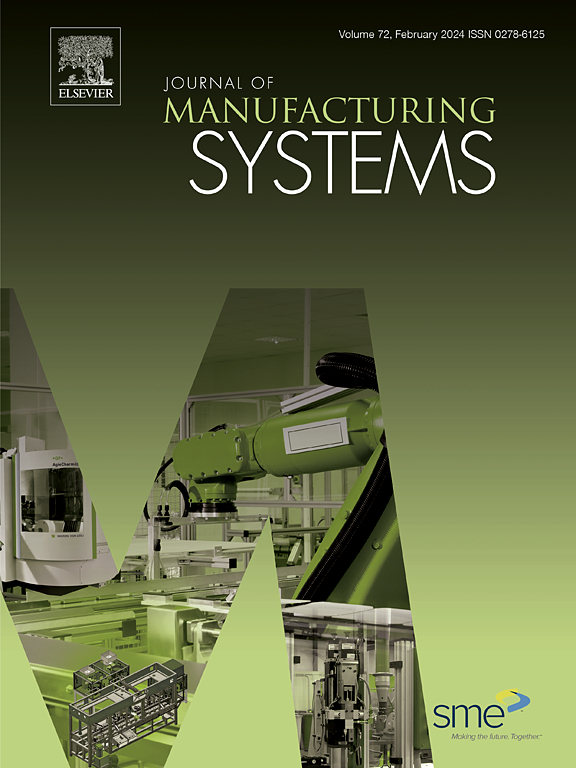Modeling of a thermo-mechanically controlled virtual finishing mill process with coupled interactive rolling automation and setup calculations
IF 14.2
1区 工程技术
Q1 ENGINEERING, INDUSTRIAL
引用次数: 0
Abstract
The steel industry is facing a big change as they are reducing carbon dioxide emissions. The transition to carbon neutral or fossil free steel manufacturing requires investments in new technologies e.g. direct reduction of iron or scrap-based production. Consequently, compact hot strip rolling lines and electric arc furnaces will replace conventional hot strip rolling processes operating with slab reheating furnaces. In compact strip production lines, the casting size is significantly larger compared to conventional process with individual slabs. This reduces the possibility of experimental rolling tests and therefore experimental testing should be replaced with modelling and simulations. In order to create a comprehensive model of the finishing mill to reduce experimental tests significantly, the virtual finishing mill is required. Therefore, the virtual finishing mill is developed to simulate hot strip production considering the boundary conditions of an industrial scale finishing rolling mill using a finite element model. Virtual finishing mill contains implemented virtual rolling automation which performs setup calculations for mill stands, mass flow control and strip tensioning between sequential rolling stands and carries out roll gap clearance adjustments for six stands finishing mill. This research focuses on mechanical process stability in full scale FE-model of finishing mill. Also, the reliable boundary conditions addressed to the hot strip in the finishing mill process are produced. Developed virtual finishing mill delivers a thorough thermo-mechanical state of the strip through the finishing mill to be further utilized by sub-models of metallurgical phenomena like recovery, precipitation and grain growth. The validation for setup calculations and FE-model are completed by comparing results of mathematical methods and comparison to industrial data.
热机控制虚拟精轧机过程的耦合交互轧制自动化和设置计算建模
在减少二氧化碳排放的过程中,钢铁行业正面临着巨大的变化。向碳中和或无化石燃料的钢铁制造过渡需要对新技术进行投资,例如直接减少铁或废料生产。因此,紧凑的热带钢轧制生产线和电弧炉将取代传统的热带钢轧制工艺与板坯加热炉操作。在紧凑型带钢生产线中,与单个板坯的传统工艺相比,铸件尺寸要大得多。这减少了进行实验性滚动试验的可能性,因此应该用建模和模拟取代实验性试验。为了建立一个完整的精轧机模型,以显著减少实验测试,需要虚拟精轧机。因此,考虑工业规模精轧机的边界条件,利用有限元模型开发虚拟精轧机,模拟热轧带钢生产。虚拟精轧机包含实现的虚拟轧制自动化,它执行轧机机架的设置计算,质量流控制和连续轧制机架之间的带钢张紧,并执行六机架精轧机的辊间隙调整。本文主要研究精轧机全尺寸有限元模型的机械过程稳定性。给出了热轧带钢精轧机过程的可靠边界条件。开发的虚拟精轧机通过精轧机提供带钢的全面热机械状态,并进一步利用恢复、沉淀和晶粒生长等冶金现象的子模型。通过对数学方法计算结果的比较和与工业数据的对比,完成了设置计算和有限元模型的验证。
本文章由计算机程序翻译,如有差异,请以英文原文为准。
求助全文
约1分钟内获得全文
求助全文
来源期刊

Journal of Manufacturing Systems
工程技术-工程:工业
CiteScore
23.30
自引率
13.20%
发文量
216
审稿时长
25 days
期刊介绍:
The Journal of Manufacturing Systems is dedicated to showcasing cutting-edge fundamental and applied research in manufacturing at the systems level. Encompassing products, equipment, people, information, control, and support functions, manufacturing systems play a pivotal role in the economical and competitive development, production, delivery, and total lifecycle of products, meeting market and societal needs.
With a commitment to publishing archival scholarly literature, the journal strives to advance the state of the art in manufacturing systems and foster innovation in crafting efficient, robust, and sustainable manufacturing systems. The focus extends from equipment-level considerations to the broader scope of the extended enterprise. The Journal welcomes research addressing challenges across various scales, including nano, micro, and macro-scale manufacturing, and spanning diverse sectors such as aerospace, automotive, energy, and medical device manufacturing.
 求助内容:
求助内容: 应助结果提醒方式:
应助结果提醒方式:


